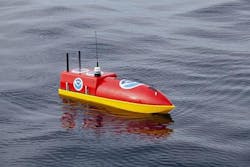Hydronalix to build unmanned surface vessel (USV) to monitor safety and for underwater communications
Officials of the Naval Air Warfare Center Aircraft Division in Lakehurst, N.J., announced plans Wednesday to award a phase-3 small business innovative research (SBIR) to Hydronalix to upgrade micro USV technology and integrate it with existing underwater acoustic communications technology.
The Naval Air Warfare Center is negotiating the SBIR phase-3 contract with Hydronalix on behalf of the Office of Naval Research Science Advisor for the Commander Fifth Fleet in Bahrain. The value of the upcoming contract has yet to be negotiated.
Hydronalix engineers will adapt a small unmanned surface boat to function as a mobile gateway buoy to support Fifth Fleet operations. The unmanned boat will act as a communications node in an underwater communications network to help protect Navy manned rigid-hull inflatable boats operating in the Persian Gulf.
Related: Not just for the Navy: unmanned surface vessels (USVs) in wide use for surveillance at NOAA
These manned Navy boats monitor port operations, perform vehicle inspections, and carry out similar operations. Navy experts say the unmanned mobile gateway buoy will enable Navy boat crews to carry out missions when other assets are not available because of bad weather, engagement limitations, and treaty agreements.
Navy officials say using the unmanned surface vessel acting as a mobile gateway buoy to monitor the operations may reduce the need to use other Navy boats, ships, and aircraft to protect the inflatable boat crews.
The unmanned surface vessel acting as a mobile gateway buoy will be capable of situational awareness, transmitting and receiving data, and be stationed aboard Navy ships and boats. Without such a system, Navy boat crews may continue to be used inefficiently and inadvertently face danger by operating in or near mine fields or unknown vessels, Navy officials say.
Ultimately, Navy researchers want to create a field-deployable system that enables Fifth Fleet explosive ordnance disposal forces to communicate remotely and track unmanned underwater vehicles (UUVs) that are involved with locating and destroying enemy sea mines.
Related: Researchers use artificial intelligence to enable unmanned surface vessels to swarm
This project could add levels of intelligence, surveillance, and reconnaissance (ISR) capability not available in existing Micro-USV systems, Navy officials say.
More information on this project is online at https://www.fbo.gov/notices/6ccb14ec824dca23066883358f5af5d5.
For additional information contact Hydronalix online at https://hydronalix.com/, or the Naval Air Warfare Center Aircraft Division-Lakehurst at www.navair.navy.mil.
Learn more: search the Aerospace & Defense Buyer's Guide for companies, new products, press releases, and videos
